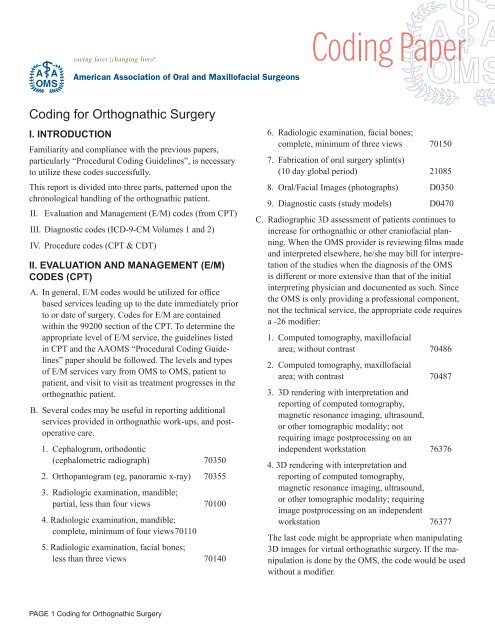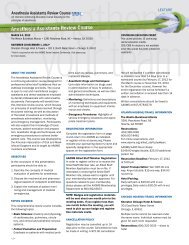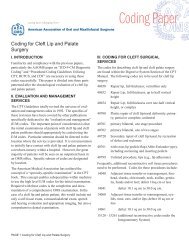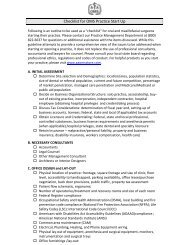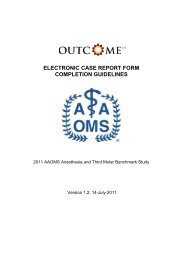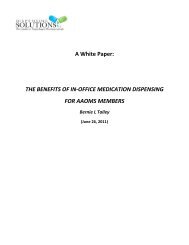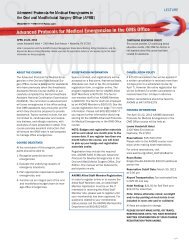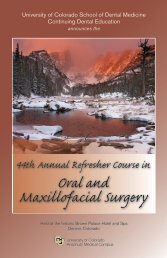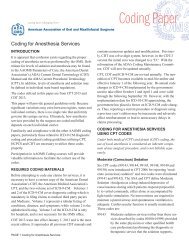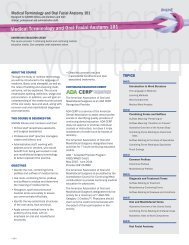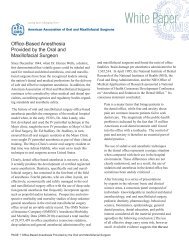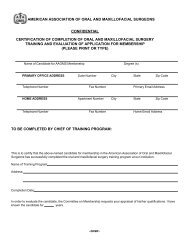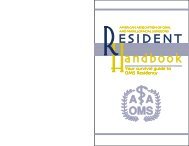Coding for Orthognathic Surgery - American Association of Oral and ...
Coding for Orthognathic Surgery - American Association of Oral and ...
Coding for Orthognathic Surgery - American Association of Oral and ...
You also want an ePaper? Increase the reach of your titles
YUMPU automatically turns print PDFs into web optimized ePapers that Google loves.
saving faces|changing lives ®<br />
<strong>Coding</strong> <strong>for</strong> <strong>Orthognathic</strong> <strong>Surgery</strong><br />
I. INTRODUCTION<br />
Familiarity <strong>and</strong> compliance with the previous papers,<br />
particularly “Procedural <strong>Coding</strong> Guidelines”, is necessary<br />
to utilize these codes successfully.<br />
This report is divided into three parts, patterned upon the<br />
chronological h<strong>and</strong>ling <strong>of</strong> the orthognathic patient.<br />
II. Evaluation <strong>and</strong> Management (E/M) codes (from CPT)<br />
III. Diagnostic codes (ICD-9-CM Volumes 1 <strong>and</strong> 2)<br />
IV. Procedure codes (CPT & CDT)<br />
II. EVALUATION AND MANAGEMENT (E/M)<br />
CODES (CPT)<br />
A. In general, E/M codes would be utilized <strong>for</strong> <strong>of</strong>fice<br />
based services leading up to the date immediately prior<br />
to or date <strong>of</strong> surgery. Codes <strong>for</strong> E/M are contained<br />
within the 99200 section <strong>of</strong> the CPT. To determine the<br />
appropriate level <strong>of</strong> E/M service, the guidelines listed<br />
in CPT <strong>and</strong> the AAOMS “Procedural <strong>Coding</strong> Guidelines”<br />
paper should be followed. The levels <strong>and</strong> types<br />
<strong>of</strong> E/M services vary from OMS to OMS, patient to<br />
patient, <strong>and</strong> visit to visit as treatment progresses in the<br />
orthognathic patient.<br />
B. Several codes may be useful in reporting additional<br />
services provided in orthognathic work-ups, <strong>and</strong> postoperative<br />
care.<br />
1. Cephalogram, orthodontic<br />
(cephalometric radiograph) 70350<br />
2. Orthopantogram (eg, panoramic x-ray) 70355<br />
3. Radiologic examination, m<strong>and</strong>ible;<br />
partial, less than four views 70100<br />
4. Radiologic examination, m<strong>and</strong>ible;<br />
complete, minimum <strong>of</strong> four views 70110<br />
5. Radiologic examination, facial bones;<br />
less than three views 70140<br />
6. Radiologic examination, facial bones;<br />
complete, minimum <strong>of</strong> three views 70150<br />
7. Fabrication <strong>of</strong> oral surgery splint(s)<br />
(10 day global period) 21085<br />
8. <strong>Oral</strong>/Facial Images (photographs) D0350<br />
9. Diagnostic casts (study models) D0470<br />
C. Radiographic 3D assessment <strong>of</strong> patients continues to<br />
increase <strong>for</strong> orthognathic or other crani<strong>of</strong>acial planning.<br />
When the OMS provider is reviewing films made<br />
<strong>and</strong> interpreted elsewhere, he/she may bill <strong>for</strong> interpretation<br />
<strong>of</strong> the studies when the diagnosis <strong>of</strong> the OMS<br />
is different or more extensive than that <strong>of</strong> the initial<br />
interpreting physician <strong>and</strong> documented as such. Since<br />
the OMS is only providing a pr<strong>of</strong>essional component,<br />
not the technical service, the appropriate code requires<br />
a -26 modifier:<br />
1. Computed tomography, maxill<strong>of</strong>acial<br />
area; without contrast 70486<br />
2. Computed tomography, maxill<strong>of</strong>acial<br />
area; with contrast 70487<br />
3. 3D rendering with interpretation <strong>and</strong><br />
reporting <strong>of</strong> computed tomography,<br />
magnetic resonance imaging, ultrasound,<br />
or other tomographic modality; not<br />
requiring image postprocessing on an<br />
independent workstation 76376<br />
4. 3D rendering with interpretation <strong>and</strong><br />
reporting <strong>of</strong> computed tomography,<br />
magnetic resonance imaging, ultrasound,<br />
or other tomographic modality; requiring<br />
image postprocessing on an independent<br />
workstation 76377<br />
The last code might be appropriate when manipulating<br />
3D images <strong>for</strong> virtual orthognathic surgery. If the manipulation<br />
is done by the OMS, the code would be used<br />
without a modifier.<br />
PAGE 1 <strong>Coding</strong> <strong>for</strong> <strong>Orthognathic</strong> <strong>Surgery</strong>
D. There are CDT codes <strong>for</strong> Cone Beam imaging [also<br />
called 3-D Imaging] which may be applicable in the<br />
radiographic assessment <strong>of</strong> some patients:<br />
<strong>Coding</strong> Paper<br />
Cone beam – three-dimensional image<br />
reconstruction using existing data,<br />
includes multiple images<br />
Image with Interpretation<br />
Cone beam CT capture <strong>and</strong> interpretation<br />
with limited field <strong>of</strong> view - less than one<br />
whole jaw<br />
Cone beam CT capture <strong>and</strong> interpretation<br />
with field <strong>of</strong> view <strong>of</strong> one full dental<br />
arch-m<strong>and</strong>ible<br />
Cone beam CT capture <strong>and</strong> interpretation<br />
with field <strong>of</strong> view <strong>of</strong> one full dental<br />
arch-maxilla, with or without cranium<br />
Cone beam CT capture <strong>and</strong> interpretation<br />
with field <strong>of</strong> view <strong>of</strong> both jaws with or<br />
without cranium<br />
Cone beam CT capture <strong>and</strong> interpretation<br />
<strong>for</strong> TMJ series including two or more<br />
exposures<br />
Image Capture Only<br />
Cone beam CT image capture with<br />
limited field <strong>of</strong> view- less than one<br />
whole jaw<br />
Cone beam CT image capture with<br />
field <strong>of</strong> view <strong>of</strong> one full dental<br />
arch- m<strong>and</strong>ible<br />
Cone beam CT image capture with<br />
field <strong>of</strong> view <strong>of</strong> one full dental<br />
arch-maxilla, with or without<br />
cranium<br />
Cone beam CT image capture with<br />
field <strong>of</strong> view <strong>of</strong> both jaws, with or<br />
without cranium<br />
Cone beam CT image capture <strong>for</strong><br />
TMJ series including two or<br />
more exposures<br />
PAGE 2 <strong>Coding</strong> <strong>for</strong> <strong>Orthognathic</strong> <strong>Surgery</strong><br />
D0363<br />
D0364<br />
D0365<br />
D0366<br />
D0367<br />
D0368<br />
D0380<br />
D0381<br />
D0382<br />
D0383<br />
D0384<br />
E. There is a family <strong>of</strong> new codes that represent<br />
procedures sometimes employed when managing<br />
patients with skeletal malocclusions, or other<br />
dentoalveolar disorders. All three codes provide<br />
skeletal anchorage <strong>and</strong> include device removal:<br />
1. Surgical Placement – temporary<br />
anchorage device [screw retained<br />
plate] requiring surgical flap<br />
2. Surgical Placement – temporary<br />
anchorage device requiring<br />
surgical flap<br />
3. Surgical Placement – temporary<br />
anchorage device without<br />
surgical flap<br />
D7292<br />
D7293<br />
D7294<br />
F. There is a code <strong>for</strong> intraoral fixation device that applies<br />
to “the placement <strong>of</strong> an intermaxillary fixation appliance<br />
used <strong>for</strong> documented medically accepted treatments<br />
not in association with fractures.”<br />
Intraoral placement <strong>of</strong> a fixation device<br />
not in conjunction with a fracture<br />
This CDT code is similar to CPT code 21110<br />
D7998<br />
III. DIAGNOSIS CODES (ICD-9-CM MANUAL<br />
VOLUMES 1 AND 2)<br />
Note: ICD-9-CM diagnostic coding conventions require<br />
the surgeon to report diagnosis codes to the highest level<br />
<strong>of</strong> specificity (use <strong>of</strong> a five-digit code rather than a fourdigit<br />
code).<br />
A. ICD-9-CM code ranges <strong>for</strong> orthognathic surgery:<br />
1. Major anomalies <strong>of</strong> jaw size (524.00 -524.09).<br />
Codes 754.0 <strong>and</strong> 526.89, discussed in paragraph B<br />
below, are specifically excluded from this section.<br />
2. Anomalies <strong>of</strong> relationship <strong>of</strong> jaw to cranial base<br />
(524.10 – 524.19)<br />
3. Anomalies <strong>of</strong> dental arch relationship<br />
(524.20 – 524.29)<br />
4. Malocclusion, unspecified 524.4 (no 5th digit)<br />
5. Dentoalveolar anomalies (524.70 – 524.79)<br />
6. Other acquired de<strong>for</strong>mity <strong>of</strong> the head<br />
(738.10 – 738.19)
B. ICD-9-CM codes <strong>for</strong> Syndromes <strong>and</strong> Conditions Requiring<br />
<strong>Orthognathic</strong> <strong>Surgery</strong><br />
Some orthognathic cases may result from syndromes<br />
<strong>and</strong> conditions requiring the surgeon to use the following<br />
codes as primary diagnoses in t<strong>and</strong>em with the<br />
developmental codes listed above (see Section IIIA).<br />
In such cases, the developmental codes will represent<br />
secondary diagnoses.<br />
These syndromes are listed below, followed by a parenthetical<br />
code <strong>and</strong> descriptor.<br />
237.7 Neur<strong>of</strong>ibromatosis/von<br />
Recklinghausen’s disease<br />
(see m<strong>and</strong>ibular asymmetry:<br />
Hyperplasia-524.02, or<br />
Hypoplasia-524.04) (5th digit required)<br />
253.0 Acromegaly (see m<strong>and</strong>ibular<br />
hyperplasia-524.02)<br />
282.4 Thalassemia (see unspecified acquired<br />
de<strong>for</strong>mity <strong>of</strong> head 738.10)<br />
(5th digit required)<br />
346.8 Mobius syndrome (see m<strong>and</strong>ibular<br />
hypoplasia-524.04)<br />
520.5 Amelogenesis imperfecta (see alveolar<br />
maxillary hyperplasia-524.71, <strong>and</strong> also<br />
m<strong>and</strong>ibular hyperplasia-524.02 usually,<br />
both <strong>of</strong> these codes will be required <strong>for</strong><br />
secondary diagnosis <strong>of</strong> amelogenesis<br />
imperfecta)<br />
526.89 Unilateral condylar hyperplasia or<br />
hypoplasia <strong>of</strong> m<strong>and</strong>ible (since this is the<br />
only code <strong>for</strong> the condyle, there is no<br />
secondary code)<br />
733.3 Hyperostosis <strong>of</strong> Skull (includes Stewart-<br />
Morel syndrome <strong>and</strong> Leontiasis ossium)<br />
733.81 Malunion <strong>of</strong> fracture (see the<br />
appropriate developmental diagnosis)<br />
(also use late effect code 905.0)<br />
733.82 Nonunion <strong>of</strong> fracture (see the<br />
appropriate developmental diagnosis)<br />
(also use late effect code 905.0)<br />
754.0 Hemifacial atrophy or hemifacial<br />
hypertrophy (see the appropriate<br />
developmental diagnosis or see<br />
unilateral condyle hyperplasia or<br />
hypoplasia or m<strong>and</strong>ible)<br />
<strong>Coding</strong> Paper<br />
755.55 Apert’s syndrome/<br />
Acrocephalosyndactyly (see maxillary<br />
hypoplasia-524.03)<br />
Pfeiffer syndrome (see maxillary<br />
hypoplasia-524.03, <strong>and</strong> unspecified<br />
acquired de<strong>for</strong>mity <strong>of</strong> head-738.10)<br />
755.59 Cleidocranial Dysplasia/<br />
Cleidocranial Dysotosis (see maxillary<br />
hypoplasia-524.03, <strong>and</strong> also alveolar<br />
maxillary hyperplasia-524.71)<br />
756.0 The following syndromes fall under ICD<br />
9 CM 756.0 [no 5th digit]:<br />
Crouzon’s disease (Crani<strong>of</strong>acial<br />
dysostosis) (see maxillary<br />
hypoplasia-524.03, <strong>and</strong> also unspecified<br />
acquired de<strong>for</strong>mity <strong>of</strong> head-738.10)<br />
Goldenhar syndrome/Hemifacial<br />
Microsomia (see m<strong>and</strong>ibular<br />
hypoplasia-524.04, <strong>and</strong> also<br />
microgenia-524.06)<br />
Hallermann-Streiff syndrome (see<br />
m<strong>and</strong>ibular hypoplasia-524.04, <strong>and</strong> also<br />
microgenia-524.06)<br />
Robin Complex/Pierre-Robin<br />
syndrome/ Robin Anomalad (see<br />
m<strong>and</strong>ibular hypoplasia-524.04, <strong>and</strong> also<br />
microgenia-524.06)<br />
Treacher-Collins syndrome/<br />
M<strong>and</strong>ibul<strong>of</strong>acial Dysostosis (see<br />
zygomatic hypoplasia-738.12,<br />
M<strong>and</strong>ibular Hypoplasia-524.04, <strong>and</strong> also<br />
unilateral condyle hypoplasia-526.89.<br />
Note: Use all secondary codes)<br />
756.4 Achondroplasia (see maxillary<br />
hypoplasia-524.03)<br />
756.51 Osteogenesis Imperfecta (see<br />
m<strong>and</strong>ibular hyperplasia-524.02)<br />
PAGE 3 <strong>Coding</strong> <strong>for</strong> <strong>Orthognathic</strong> <strong>Surgery</strong>
756.52 Osteopetrosis/Albers-Schonberg’s<br />
disease (see maxillary hypoplasia,<br />
524.03, <strong>and</strong> also m<strong>and</strong>ibular hypoplasia,<br />
524.04)<br />
756.55 Chondroectodermal Dysplasia/Ellis-<br />
Van Creveld syndrome (see m<strong>and</strong>ibular<br />
hypoplasia-524.04, <strong>and</strong> also unilateral<br />
condyle hypoplasia, 526.89)<br />
756.83 Ehlers-Danlos syndrome (see alveolar<br />
maxillary hyperplasia-524.71)<br />
758.7 Klinefelter syndrome (see m<strong>and</strong>ibular<br />
hyperplasia-524.02)<br />
759.82 Marfan syndrome (see m<strong>and</strong>ibular<br />
hyperplasia-524.02)<br />
759.89 Gorlin syndrome/Basal Cell Nevus<br />
syndrome (see unspecified acquired<br />
de<strong>for</strong>mity <strong>of</strong> head-738.10, <strong>and</strong> also<br />
m<strong>and</strong>ibular hyperplasia-524.02)<br />
780.53 Hypersomnia with sleep apnea<br />
(see maxillary hypoplasia-524.03,<br />
m<strong>and</strong>ibular hypoplasia-524.04, <strong>and</strong> also<br />
microgenia-524.08, Note: Use all three<br />
secondary codes, if appropriate)<br />
IV. PROCEDURE CODES (CPT)<br />
CPT codes are used to report orthognathic surgery procedures<br />
using the CMS-1500 claim <strong>for</strong>m. Since orthognathic<br />
procedures are most likely covered by medical carriers,<br />
discussion here will be limited to CPT codes. Note,<br />
however, with the implementation <strong>of</strong> “recognized code<br />
sets” under HIPAA, “D-codes” may be used <strong>for</strong> reporting<br />
purposes if an appropriate CPT code is not available. For<br />
example, D7944 Osteotomy – segmented or subapical,<br />
Report by range <strong>of</strong> tooth numbers within the segment”<br />
may actually be an exception to the rule that orthognathic<br />
procedures are more specific in CPT as opposed to CDT.<br />
Technically, the CPT 21198, although it says “segmental,”<br />
is not clearly subapical; 21199 includes genial tubercle<br />
(which is in basilar bone), <strong>and</strong> 21206 cites examples<br />
that are not clearly segmental <strong>and</strong> do not really have the<br />
specificity that D7944 has. The existence <strong>of</strong> a code (CPT<br />
or CDT) does not guarantee reimbursement <strong>for</strong> the service.<br />
A. General Guidelines<br />
<strong>Coding</strong> Paper<br />
1. Global surgical package: A given surgical procedure<br />
code usually comprises services provided within<br />
24 hours prior to surgery, the surgical procedure,<br />
postoperative care in the hospital, <strong>and</strong> routine postoperative<br />
care in the <strong>of</strong>fice. This period is usually<br />
90 days, since orthognathic surgery is considered a<br />
major surgical procedure.<br />
2. Hospital discharge services (99238) are considered<br />
part <strong>of</strong> the surgical package <strong>and</strong> would not be used<br />
by the surgeon <strong>for</strong> services done on the final day <strong>of</strong><br />
hospitalization. In general, the surgeon should not<br />
bill any E/M service codes during the patient’s stay<br />
related to an orthognathic procedure. However, a<br />
Significant, Separately Identifiable E&M Service by<br />
the Same Physician on the Same Day <strong>of</strong> the Procedure<br />
can be submitted using the appropriate E/M<br />
code <strong>and</strong> -25 modifier <strong>and</strong> appropriate documentation.<br />
3. Postoperative visit (99024) is used to report routine<br />
postoperative visits during the global period <strong>for</strong> the<br />
surgery, usually 90 days <strong>for</strong> orthognathic surgery.<br />
This code is <strong>for</strong> reporting purposes only, as reimbursement<br />
<strong>for</strong> routine postoperative care is typically<br />
included in the surgical code itself.<br />
4. Postoperative x-rays, even when done within the<br />
global period, may be billed (they are not considered<br />
to be a routine E&M service). Postoperative services<br />
which significantly exceed normal postoperative<br />
care may be submitted with an appropriate E/M<br />
code <strong>and</strong> the –25 modifier. Modifier -25 is defined<br />
as a Significant, Separately Identifiable E&M Service<br />
by the Same Physician on the Same Day <strong>of</strong> the<br />
Procedure or Other Service. A letter <strong>of</strong> explanation<br />
<strong>and</strong> clear documentation to substantiate the claim<br />
will usually be required<br />
5. Postoperative services delivered within the global<br />
period, but which are unrelated to the original procedure,<br />
may be billed using modifier -24.<br />
6. An unplanned but related return to the operating or<br />
procedure room during the postoperative period is<br />
reported with a -78 modifier.<br />
7. These codes are considered to be inherently bilateral.<br />
Do not add the bilateral modifier.<br />
8. When reporting a unilateral m<strong>and</strong>ible ramus procedure,<br />
use the “-52” modifier (Reduced Services).<br />
PAGE 4 <strong>Coding</strong> <strong>for</strong> <strong>Orthognathic</strong> <strong>Surgery</strong>
B. Reporting <strong>Orthognathic</strong> <strong>Surgery</strong> Procedures:<br />
1. In general, use codes in the range 21120- 21209.<br />
Code “21210, Graft, bone; nasal, maxillary, or malar<br />
areas (includes obtaining graft),” should not be<br />
combined with LeFort codes 21145-21147, or higher<br />
level LeFort codes 21151 through 21160, unless the<br />
21210 related graft is totally separate from the Le-<br />
Fort procedure. Modifiers -51 <strong>and</strong> -52 would apply.<br />
2. Use the “-51” modifier on multiple procedures <strong>and</strong><br />
follow CPT Guidelines.<br />
3. Osteotomy codes “requiring a bone graft”, but<br />
which specify “includes obtaining autograft,” or<br />
“includes obtaining graft,” should be appended<br />
with a -52 modifier if an allograft is utilized. The<br />
same principle would apply to the 21210 <strong>and</strong> 21215<br />
codes.<br />
4. Use the same descriptor <strong>for</strong> better communication<br />
<strong>and</strong> to avoid confusion.<br />
21196 is the same as “SSO with bone plates,” “Obwegeser<br />
osteotomy with RIF,” <strong>and</strong> “Sliding osteotomy<br />
with rigid fixation.”<br />
5. If a second surgeon, assistant surgeon, co-surgeon<br />
operates, the appropriate modifier should be used<br />
(see modifiers -62, -66, -80, -81, -82 listed in Appendix<br />
A <strong>of</strong> your CPT manual).<br />
6. Application <strong>of</strong> interdental fixation device <strong>for</strong> conditions<br />
other than fracture or dislocation includes<br />
removal (21110)<br />
C. A Word about Distraction Osteogenesis (DO)<br />
DO is essentially an osteotomy, not taken to<br />
completion, with application <strong>of</strong> an appliance <strong>and</strong><br />
subsequent adjustments to move the osteotomy<br />
segments. It is coded using the appropriate osteotomy<br />
code with a -52 modifier, as well as 20690 (Application<br />
<strong>of</strong> a uniplane [pins or wires in one plane], unilateral,<br />
external fixation system) or 20692 (Application <strong>of</strong><br />
a multiplane [pins or wires in more than one plane],<br />
unilateral, external fixation system [eg, Ilizarov,<br />
Monticelli type]. Both 20690 <strong>and</strong> 20692 are unilateral<br />
codes, <strong>and</strong> the -50 modifier would be used <strong>for</strong> a<br />
<strong>Coding</strong> Paper<br />
bilateral procedure. 20693 is used if adjustment <strong>of</strong><br />
an external distractor device requires IV sedation or<br />
general anesthesia. If an external distractor is adjusted<br />
without anesthesia or with only local anesthesia within<br />
the global period, the service is not billed. The same<br />
principles apply <strong>for</strong> the use <strong>of</strong> CPT 20694, removal,<br />
under anesthesia, <strong>of</strong> external fixation system.<br />
D. Adjunctive Procedures<br />
1. Generally excluded as “Cosmetic”<br />
a. Lipectomy (15838)<br />
b. Facial implants <strong>for</strong> augmentation<br />
(21125)<br />
c. Bony augmentation <strong>and</strong> osteoplasty<br />
(21127, 21208 – 21209)<br />
d. Genioplasty <strong>for</strong> cosmetic reasons<br />
(21120-21123)<br />
(Reporting does not assure<br />
reimbursement if the procedure is<br />
contractually excluded by the carrier)<br />
2. Genioplasty <strong>for</strong> sleep apnea (hypersomnia with<br />
sleep apnea-780.53) should be submitted with documentation<br />
<strong>of</strong> the diagnosis, such as sleep studies,<br />
notes, etc.<br />
3. Platelet Rich Plasma (PRP) is sometimes used<br />
as an adjunct to certain orthognathic procedures.<br />
When appropriate, it is reported with 0232T- injection(s),<br />
platelet rich plasma, any tissue, including<br />
image guidance, harvesting <strong>and</strong> preparation when<br />
per<strong>for</strong>med. Code 0232T is a category III CPT code<br />
which is a temporary code describing an emerging<br />
technology, service <strong>and</strong> /or procedure that may or<br />
may not eventually be converted to a Category I<br />
CPT code.<br />
PAGE 5 <strong>Coding</strong> <strong>for</strong> <strong>Orthognathic</strong> <strong>Surgery</strong>
V. SUMMARY<br />
This paper is intended to be a general guideline <strong>for</strong> orthognathic<br />
surgery diagnostic <strong>and</strong> procedural coding. In order<br />
to stay current with the evaluation <strong>and</strong> management (CPT)<br />
codes, the diagnosis (ICD-9-CM) codes, <strong>and</strong> the procedure<br />
(CPT & CDT) codes, members should use the most current<br />
coding manuals. AAOMS publications such as AAOMS<br />
Today will provide updates <strong>and</strong> advisory opinions. Members<br />
are also encouraged to participate in AAOMS <strong>Coding</strong><br />
courses <strong>for</strong> additional training. Contact the AAOMS <strong>for</strong><br />
the current <strong>Coding</strong> <strong>and</strong> Billing courses brochure.<br />
Note: This paper should not be used as the sole reference in coding.<br />
Both diagnosis <strong>and</strong> treatment codes change frequently, <strong>and</strong> insurance<br />
carriers may differ in their interpretations <strong>of</strong> the codes.<br />
<strong>Coding</strong> <strong>and</strong> billing decisions are personal choices to be made by<br />
individual oral <strong>and</strong> maxill<strong>of</strong>acial surgeons exercising their own pr<strong>of</strong>essional<br />
judgment in each situation. The in<strong>for</strong>mation provided to you in<br />
this paper is intended <strong>for</strong> educational purposes only. In no event shall<br />
AAOMS be liable <strong>for</strong> any decision made or action taken or not taken<br />
by you or anyone else in reliance on the in<strong>for</strong>mation contained in this<br />
article. For practice, financial, accounting, legal or other pr<strong>of</strong>essional<br />
advice, you need to consult your own pr<strong>of</strong>essional advisers.<br />
<strong>Coding</strong> Paper<br />
This is one in a series <strong>of</strong> AAOMS papers designed to provide<br />
in<strong>for</strong>mation on coding claims <strong>for</strong> oral <strong>and</strong> maxill<strong>of</strong>acial surgery<br />
(OMS). This paper discusses coding <strong>for</strong> orthognathic surgery.<br />
This paper is to aid the oral <strong>and</strong> maxill<strong>of</strong>acial surgeon with<br />
proper diagnosis (ICD-9-CM) <strong>and</strong> treatment (CPT/CDT) coding<br />
<strong>for</strong> orthognathic surgery. When indicated, you will be referred to<br />
the appropriate area <strong>of</strong> the coding books where the principles <strong>of</strong><br />
coding illustrated in this paper may be applied.<br />
Proper coding provides a uni<strong>for</strong>m language to describe medical,<br />
surgical, <strong>and</strong> dental services. Diagnostic <strong>and</strong> procedure codes<br />
are continually updated or revised. The AAOMS Committee on<br />
Health Care <strong>and</strong> Advocacy has developed these coding guidelines<br />
in order to assist the membership to use the coding systems<br />
effectively <strong>and</strong> efficiently.<br />
© 2013 <strong>American</strong> <strong>Association</strong> <strong>of</strong> <strong>Oral</strong> <strong>and</strong> Maxill<strong>of</strong>acial Surgeons.<br />
No portion <strong>of</strong> this publication may be used or reproduced without<br />
the express written consent <strong>of</strong> the <strong>American</strong> <strong>Association</strong> <strong>of</strong> <strong>Oral</strong><br />
<strong>and</strong> Maxill<strong>of</strong>acial Surgeons.<br />
Revised March 2013<br />
PAGE 6 <strong>Coding</strong> <strong>for</strong> <strong>Orthognathic</strong> <strong>Surgery</strong>


